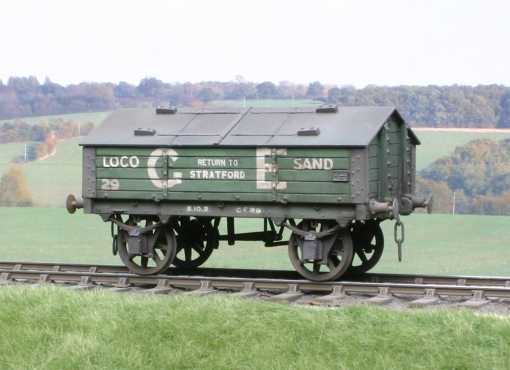When production of the 600 diagram 32 8-plank loco coal wagons ceased in 1902 the total stock of this type stood at 2047. It was a thoroughly modern fleet with the oldest being introduced only eleven years earlier, and all bar one were rated at 10 tons.
At the turn of the century there was widespread interest in high-capacity coal wagons with their significantly lower tare to capacity ratio over the traditional 10 ton wagon, and in 1900 Holden introduced an experimental 15 ton wagon to diagram 33. However the wagon didn’t find favour, and the following year the company hired a 30 ton capacity wagon from Leeds Forge & Co. for £1 10s 0d per week, initially employing it on the Parkston to Bishopsgate service before sending it over other parts of the system. The ‘truck of large carrying capacity’ was rejected by collieries as it couldn’t be fully loaded – and so never realised its full potential – and the single side door proved to be impractical for unloading, so the GER returned it to its makers.

The first of the line, no.933 built in the spring of 1902. The rest of the batch were numbered 1 to 61 and were the only batch to be fitted with a form of Parker’s either side brakes (note the short brake lever) and the experimental large and very modern ‘squared’ letters and numbers. A photograph of no.65 taken in early 1903 shows the more familiar large rounded letters. These wagons were fitted with Holden’s split ‘R’ type axleboxes from new. Photograph ©Public Domain.
While the company continued to make use of its 10 ton fleet, Holden designed a new all-steel wagon of 20 tons capacity (perhaps with an eye on the recently introduced N4 and N3 20 ton wagons on the Great Western), consulting with and receiving assurances from enough collieries that they would be accepted for loading to capacity. Production of the diagram 46 wagons commenced in 1902 and proved to be highly successful – a 400 ton train saving 10% in tare weight and over 30% in train length.
So successful was the design that further batches totalling 901 examples were built each year except 1915 and 1917-1919 down to 1920, and in consequence 650 of the diagram 31 loco coal wagons built during the 1890s were converted to diagram 48 high-sided general merchandise wagons between 1904 and 1911.

No 587 of the 1910 batch on 1 September of that year. This was the final Order to have the single brake lever acting on all four brake blocks, and from 1911 the Morton brake was fitted to new builds. The more familiar 1903 livery was applied down to, and sometimes beyond(!), Grouping. Photograph ©Public Domain.
To details; the steel wagons were 21′ 6″ over headstocks, had a 12′ wheelbase and Holden’s split ‘R’ type oil axleboxes were fitted. The first batch were fitted with Parker’s ‘either side’ brake gear which wasn’t particularly fail-safe, and in time was removed. The second batch built in 1903 had a single lever on one side of the wagon acting on all four wheels via yokes – the cross-shaft extending half-way across the wagon where the inboard end was supported by a support post, and this design was continued well beyond the period covered by Basilica Fields, up to and including the 1910 batch ending with wagon number 690. From number 691 of 1911 the either side brake lever issue was resolved with the introduction of the Morton clutch which was applied to all new builds and in time retrospectively fitted to all earlier builds.
Modelling the Diagram 46 wagons
Fortuitously D&S Models include these loco coal wagons in the range, but need to be backdated to cater for the GER period.

Here’s a shelf-queen by D&S which I started many years ago and have, shamefully, still not completed. I do have a rather lame but legitimate excuse that the axleboxes provided in the kit were completely wrong for the GE period, and I only managed to source some of the ‘R’ type a couple of years ago (thanks Mick!). I suppose there’s no excuse not to finish it now, nor the other half dozen in the pile… Photograph ©2007 Adrian Marks
References
There are various GA drawings at the NRM in York, one for the experimental diagram 33 and three for the 20T wagon dated 1908, 1912 and 1914.
Drawing no. 11290, Loco coal wagon, 15 tons, 8 plank, 18ft. Date: June 1900. Stratford Order E51, diagram 33W
Drawing no. 16285, Loco coal wagon, 20 tons, 21ft 6ins. Date: January 1908. Stratford Order R63, diagram 46W
Drawing no. 18248, Loco coal wagon, 20 tons, 21ft 6ins. Date September 1912. Stratford Order M73, diagram 46W
Drawing no. 19554, Loco coal wagon, 20 tons, 21ft 6ins. Date 28 October 1914. Stratford Order H77, diagram 46W for batches built 1916-1921.





